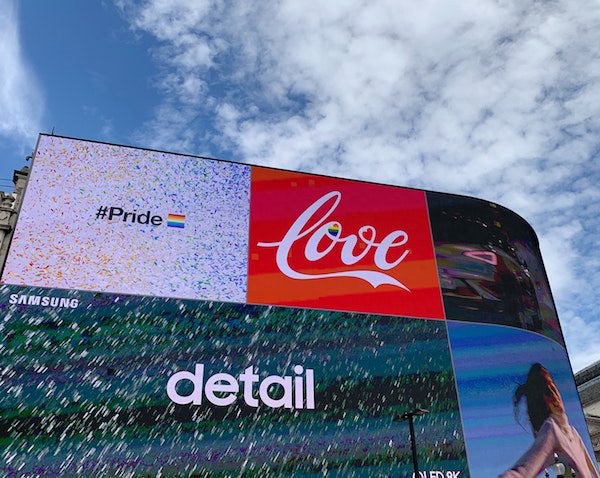pDOOH comes of age

Programmatic digital out-of-home advertising is revolutionising the way we advertise outdoors. You’ll never look at a billboard the same way again.
The more involved you become in marketing and advertising, the more you get used to hearing references to programmatic advertising. Programmatic advertising refers to the sale and purchase of advertising space in real time, through software used to automate the buying, placement and optimisation of media inventory.
Put very simply: programmatic media buying uses computer algorithms and various data sources to serve the right advertising to the right audience at the right time. The pricing is based on the real-time balance of available inventory and demand.
Programmatic advertising has rapidly become a reality in the outdoor advertising space, with 2020 being touted as the year for programmatic digital out-of-home, or pDOOH as it is widely known.
In its most simplistic form, the pDOOH transaction between advertiser and media owner looks like this:

Advertisers load their various targeting and budget options on the “demand side” through a demand side platform (DSP), which can have many different variations depending on the unique objectives and needs of the client or campaign. Media owners load their inventory on the “supply side” through a Supply Side Platform (SSP). Media owners can programme things like pricing and load the inventory they want to be sold. The ad exchange then essentially brokers a deal between the two parties, all of which happens in a matter of milliseconds.
The most common option for buying pDOOH is through real-time bidding, also known as the open auction. In this scenario an ad slot is offered to a group of buyers, who automatically place bids according to how much the slot is worth to them. Instantaneously, the system assigns the slot to the best bid, the transaction is completed, and the ad is delivered.
What makes it different?
So you may ask: How does pDOOH differ from other programmatic channels such as online or mobile advertising? Online or mobile advertising is almost always a one-to-one ad serve, which means an advertiser is serving an advert to ONE individual based on information (browsing history and so forth) about that individual.
pDOOH is a one-to-many ad serve, so its measurement differs in terms of what is called an impression multiplier. For mobile and online advertising, there is always a 1:1 ad served: impression generated ratio. But a single pDOOH ad serve could equate to thousands of impressions depending on the location, time of day and generic traffic density.
As a result, the type of data used and campaign reporting may differ slightly, but just like with traditional programmatic purchases, advertisers can layer and fuse any number of datasets and insights to serve a more targeted and effective advert through pDOOH.
Evolving outdoor advertising
Leading DSPs in the market today are integrating pDOOH into their buying platforms and allowing advertisers to buy online and DOOH inventory simultaneously, essentially making each digital billboard panel a mobile screen. The race to a truly programmatic environment is being led by global giants like JCDecaux and Clear Channel Outdoor, which are already making most of their inventory available programmatically.
As more media owners and DSPs begin to support programmatic pDOOH and more buyers begin incorporating the medium into their campaigns, the format will inevitably become an integral part of most mainstream digital media buys.
This is where the potential for pDOOH gets exciting. Rather than cannibalise the OOH market, pDOOH enhances the probability of increased advertising spend for the sector, tapping into campaigns that would not normally be allocated to OOH.
An important point to note is that there is nothing that can be done programmatically that cannot already be accomplished with a direct buy. The key differentiator in pDOOH lies in the speed and efficiency at which you can deliver relevant messaging to your target market. Instead of multiple direct buys with various media owners, you can buy through one single DSP quickly and easily, optimising your time and your budget.
Data-driven DOOH
From a content perspective, DOOH companies are already seeing the value in integrating various datasets like location data and mobility data to get real-time views of audience and movement around their displays.
There is also no limit to the ways in which external data can be used to trigger DOOH adverts. For instance, setting content to change in response to time or weather parameters is a simple and effective option for ensuring contextually relevant ads for that time of the day when consumers are in the right frame of mind to buy a product. Other data sources include live daily stock-market performance, real-time scores coming from sporting events and integration with social-media feeds.
Platforms like Quividi and AdMobilize let DOOH networks use camera sensors that can detect things like audience demographics, dwell times, engagement and more. Variations on this technology include facial- and gender-recognition software, and eye-tracking software. As technology advances, we are seeing dynamic-pricing adverts linked to sales that change content based on the availability of products in store. And, of course, the more triggers and more data sources used, the more granular the targeting can be for a pDOOH campaign.
As pDOOH comes of age we can expect more locations, better tools, more effective campaign measurement and more captivating creative executions. Not only will pDOOH drive growth in ad spend, making a bigger advertising pizza with bigger slices for everyone, but with all the platform, content and creative options, everyone can have their favourite topping on their slice.
Source: Alasdair Muller
Alasdair Muller is the business development director at Guerrilla IMC. He is an OOH and technology fanatic with more than 13 years’ advertising and marketing experience. Muller has served in senior management roles at JCDecaux Africa, EOH Mthombo and The Media Factory.


